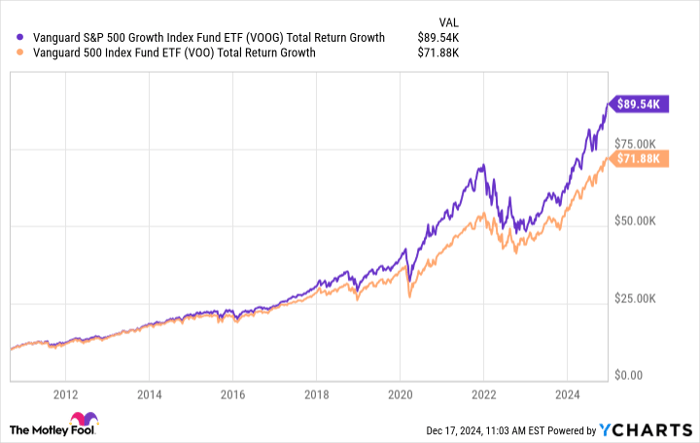Many investors know about the Vanguard S&P 500 ETF, one of the easiest ways to invest in the broader market. But Vanguard actually has more than 80 different exchange-traded funds (ETFs) that meet a varied list of investor criteria.
As you might imagine, its growth ETFs are performing exceptionally well this year. That’s typical when the market itself does well. When the S&P 500 (SNPINDEX: ^GSPC) is up, growth stocks, as a category, usually beat it. When it’s down, growth stocks underperform. It’s the opposite for value stocks, which tend to do better when the market is down but may underperform when the market is up.
Where to invest $1,000 right now? Our analyst team just revealed what they believe are the 10 best stocks to buy right now. See the 10 stocks »
Vanguard has several growth ETFs, and the one that is performing above all the rest this year is the S&P 500 Growth ETF (NYSEMKT: VOOG). Let’s see why, and whether or not it’s still a buy for 2025.
Growth + diversification = a top ETF
The S&P 500 Growth ETF, like all of Vanguard’s ETFs, tracks an index. This ETF tracks the S&P 500 Growth index, a group of about 230 of the highest-growth stocks in the benchmark.
While it’s clearly not as diversified as the S&P 500, 230 stocks still make for quite a diverse portfolio. That provides a safety cushion. And because it’s not actively managed, investors don’t have to sit there and choose their own 230 stocks. They also don’t have to worry about selling duds and making more effort to find replacements. That’s a general benefit of buying an ETF.

Image source: Getty Images.
This ETF has an expense ratio of 0.1% as compared with 0.95% for similar ETFs. It’s actually one of Vanguard’s most expensive ETFs, but it’s also a top performer. It’s up 36% in 2024, beating the market’s 25% increase and leading all of Vanguard’s 88 ETFs.
Beating the market in good times and overall
As mentioned above, it’s not surprising that growth stocks are outperforming the market right now. But what’s compelling about the S&P 500 Growth ETF is that it has a better long-term track record, with an annualized gain of 16.4%, than the standard S&P 500 ETF’s 14.9% over similar periods of time.
Here’s how it would look if you had invested $10,000 in each of those ETFs when they started.

VOOG Total Return Level data by YCharts.
Can it repeat in 2025?
Since the ETF follows a weighted index, the highest market-cap stocks account for a disproportional amount of the total. The five largest stocks in the portfolio, Apple, Nvidia, Microsoft, Amazon, and Meta Platforms, account for 45.8% of the total. On the other side, about half of the stocks each account for 0.1% or less of the total.
Today, these large companies are performing extremely well and have massive opportunities in artificial intelligence (AI). So by default, growth ETFs not only give investors exposure to the most profitable AI trends but also shield them from a lot of risk associated with investing in a single stock or less diversified fund. It also has plenty of established and stable stocks, like Visa and Costco Wholesale, which balance out some of the riskier stocks. Vanguard gives this ETF a risk rating of 4 out of 5, which is high, but not the highest.
Considering today’s tech opportunities in AI, I think the S&P 500 Growth ETF is likely to keep climbing in 2025. Its excellent long-term record assures me it’s a sound investment for most investors, whatever the next year holds.
Should you invest $1,000 in Vanguard Admiral Funds – Vanguard S&P 500 Growth ETF right now?
Before you buy stock in Vanguard Admiral Funds – Vanguard S&P 500 Growth ETF, consider this:
The Motley Fool Stock Advisor analyst team just identified what they believe are the 10 best stocks for investors to buy now… and Vanguard Admiral Funds – Vanguard S&P 500 Growth ETF wasn’t one of them. The 10 stocks that made the cut could produce monster returns in the coming years.
Consider when Nvidia made this list on April 15, 2005… if you invested $1,000 at the time of our recommendation, you’d have $800,876!*
Stock Advisor provides investors with an easy-to-follow blueprint for success, including guidance on building a portfolio, regular updates from analysts, and two new stock picks each month. The Stock Advisor service has more than quadrupled the return of S&P 500 since 2002*.
*Stock Advisor returns as of December 16, 2024
John Mackey, former CEO of Whole Foods Market, an Amazon subsidiary, is a member of The Motley Fool’s board of directors. Randi Zuckerberg, a former director of market development and spokeswoman for Facebook and sister to Meta Platforms CEO Mark Zuckerberg, is a member of The Motley Fool’s board of directors. Jennifer Saibil has positions in Apple. The Motley Fool has positions in and recommends Amazon, Apple, Costco Wholesale, Meta Platforms, Microsoft, Nvidia, Vanguard S&P 500 ETF, and Visa. The Motley Fool recommends the following options: long January 2026 $395 calls on Microsoft and short January 2026 $405 calls on Microsoft. The Motley Fool has a disclosure policy.
The views and opinions expressed herein are the views and opinions of the author and do not necessarily reflect those of Nasdaq, Inc.

